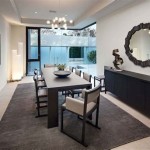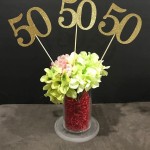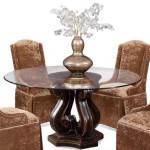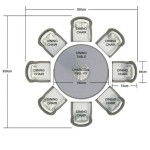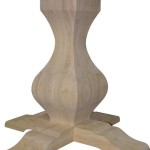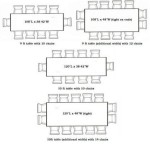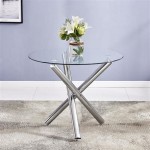Decorating Your Round Dining Table: A Guide to Style and Function
A round dining table fosters intimacy and conversation, making it a popular choice for smaller dining spaces and those seeking a more convivial atmosphere. However, the centerpiece and surrounding decor can significantly impact the overall aesthetic and functionality of the room. This article will explore various aspects of decorating a round dining table, focusing on creating visually appealing arrangements that enhance both the table's form and the dining experience.
Understanding the Proportions and Scale
The first crucial step in decorating a round dining table is understanding the interplay of proportions and scale. A centerpiece that is too large will overwhelm the table and impede conversation across the table. Conversely, a centerpiece that is too small will appear insignificant and lost in the expanse of the tabletop. The diameter of the table directly dictates the appropriate size and scale of the decorative elements.
For smaller round tables (under 48 inches in diameter), a single, well-chosen centerpiece is often sufficient. This could be a vase of flowers, a candle grouping, or a sculptural object. Larger round tables (over 60 inches in diameter) can accommodate more elaborate arrangements, potentially incorporating multiple elements or a larger, more impactful central feature. The height of the decorations also needs careful consideration. Tall centerpieces can obstruct views and hinder conversation. A general guideline is to keep the centerpiece below 12 inches in height, or significantly above eye level when seated. This ensures visibility and facilitates effortless communication among diners.
Beyond the centerpiece, consider the scale of other decorative elements, such as placemats, chargers, and dinnerware. Overly bulky or ornate settings can detract from the table's clean lines and create a cluttered appearance. Opt for simpler, more streamlined designs that complement the table's shape and size. Similarly, the surrounding furniture should be in proportion to the table. Oversized chairs around a small round table will overwhelm the space, while undersized chairs around a large round table will look disproportionate.
Exploring Centerpiece Options: Functionality and Aesthetics
The centerpiece is the focal point of a round dining table, and its selection should reflect both personal style and the desired ambiance of the dining space. The possibilities are virtually limitless, ranging from classic floral arrangements to modern sculptural pieces. A key consideration is the functionality of the centerpiece. Does it serve a practical purpose, such as holding candles or showcasing food, or is it purely decorative?
Floral arrangements are a timeless choice, adding a touch of natural beauty and elegance to the table. Opt for a single, impactful arrangement or a collection of smaller vases with varying heights and textures. Seasonal flowers can easily transform the table's aesthetic, reflecting the changing colors and moods of the year. When choosing floral arrangements, consider the color palette of the dining room and select flowers that complement the existing decor. Fragrance is also an important factor. Avoid overly fragrant flowers that could interfere with the enjoyment of the meal.
For a more modern and minimalist aesthetic, consider using sculptural objects as centerpieces. These can range from abstract metal sculptures to geometric ceramic pieces. The key is to choose an object that is visually interesting and complements the table's shape and finish. Groupings of candles are another popular option, creating a warm and inviting atmosphere. Use varying heights of candlesticks or pillar candles to add visual interest. Consider incorporating candle holders that reflect the table's style, such as sleek metal holders for a modern table or ornate crystal holders for a more traditional table.
Functional centerpieces can also be both beautiful and practical. A tiered serving stand can be used to display appetizers or desserts, adding height and visual interest to the table. A lazy Susan, especially for larger round tables, can facilitate sharing and conversation, allowing diners to easily access dishes placed in the center of the table. Similarly, a decorative bowl filled with fruit or vegetables can serve as both a centerpiece and a source of healthy snacks.
Incorporating Linens and Accessories: Enhancing the Table Setting
Linens and accessories play a crucial role in completing the overall aesthetic of a round dining table. The choice of tablecloth, placemats, napkins, and dinnerware can significantly impact the table's style and formality. Consider the occasion and the desired ambiance when selecting these elements.
A tablecloth is not always necessary for a round dining table, especially if the table has a beautiful wood or stone top. However, a tablecloth can add a touch of elegance and formality, particularly for special occasions. Choose a tablecloth that is appropriate for the table's size and shape. A round tablecloth is ideal, but a square or rectangular tablecloth can also work if draped carefully to create a balanced look. The color and fabric of the tablecloth should complement the overall decor of the dining room. Linen is a classic choice, offering a sophisticated and timeless look. Cotton is a more casual option, while silk or velvet can add a touch of luxury.
Placemats can be used to protect the table from spills and scratches, while also adding a decorative touch. Round placemats are a natural choice for a round table, but square or rectangular placemats can also work if positioned carefully. Choose placemats that complement the table's style and the color of the dinnerware. Woven placemats can add texture and warmth, while metallic placemats can add a touch of glamour. Napkins are an essential element of any table setting. Choose napkins that complement the placemats and dinnerware. Linen napkins are a classic choice, while cotton napkins are a more casual option. Fold the napkins in a simple and elegant manner, or use napkin rings to add a touch of personality.
The choice of dinnerware can significantly impact the table's overall aesthetic. Opt for dinnerware that complements the table's style and the occasion. White dinnerware is a classic and versatile choice, providing a neutral backdrop for food. Colored dinnerware can add a pop of personality, but be sure to choose colors that complement the overall decor of the dining room. Consider the shape and size of the dinnerware. Smaller plates and bowls are ideal for smaller round tables, while larger plates and bowls can be used on larger round tables. Glassware is another important element of the table setting. Choose glassware that complements the dinnerware and the occasion. Wine glasses, water glasses, and juice glasses can all be arranged on the table to create a visually appealing and functional setting.
Finally, consider adding personal touches to the table setting. Small decorative accents, such as place card holders, small vases of flowers, or decorative stones, can add personality and charm. The key is to keep the decor simple and uncluttered, allowing the food and the company to take center stage.
Lighting and Ambiance: Setting the Mood
Lighting plays a crucial role in creating the desired ambiance in a dining room. The type and intensity of lighting can significantly impact the mood and atmosphere of the space. For a round dining table, it is essential to choose lighting that is both functional and aesthetically pleasing.
A chandelier or pendant light suspended directly above the table is a classic and effective way to illuminate the space. Choose a light fixture that is proportional to the table's size and shape. A too-small light fixture will look insignificant, while a too-large light fixture will overwhelm the space. The height of the light fixture is also important. It should be low enough to provide adequate illumination but high enough to avoid obstructing views or hitting heads. A general guideline is to hang the light fixture approximately 30-36 inches above the tabletop.
In addition to the overhead lighting, consider incorporating other light sources to create a more layered and nuanced ambiance. Table lamps can add warmth and intimacy to the space, while wall sconces can provide ambient lighting and highlight architectural features. Dimmer switches are an excellent way to control the intensity of the lighting, allowing you to adjust the mood to suit the occasion. Candles are another classic way to create a warm and inviting atmosphere. Use varying heights of candlesticks or pillar candles to add visual interest. Scented candles can also add a touch of fragrance to the dining room, but be sure to choose scents that are not overpowering or that clash with the aroma of the food.
The color and quality of light are also important considerations. Warm light (2700-3000K) is more inviting and flattering than cool light (4000-5000K). Avoid using harsh fluorescent lighting, as it can create a sterile and unappealing atmosphere. Consider using LED bulbs, which are energy-efficient and available in a wide range of colors and intensities.

Gorgeous Round Table Centerpiece Ideas For Summer Perfecting Places

How To Decorate A Round Dining Table 10 Ideas Modern Farmhouse Room Decor Rooms Small

Gorgeous Round Table Centerpiece Ideas For Summer Perfecting Places

30 Spectacular Round Dining Table Centerpiece Ideas To Enhance Your Home

Gorgeous Round Table Centerpiece Ideas For Summer Perfecting Places

35 Admirable Ideas For Decorating A Round Dining Table

Why You May Need A Round Dining Table Room Makeover Farmhouse Rooms Decor

Seating Ideas Tips For Round Dining Tables Artisan Crafted Iron Furnishings And Decor Blog

10 Stunning Decorating Ideas To Style A Round Dining Room Table

Round Dining Table Design Ideas

